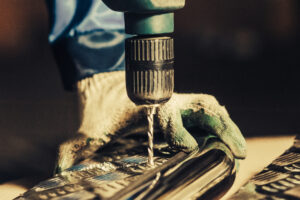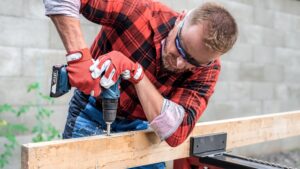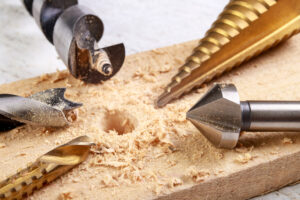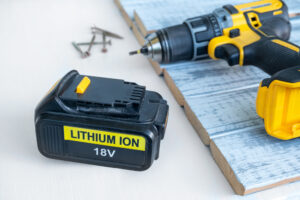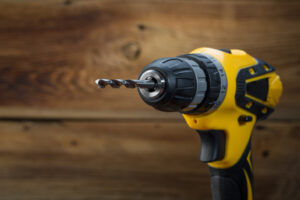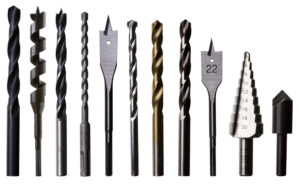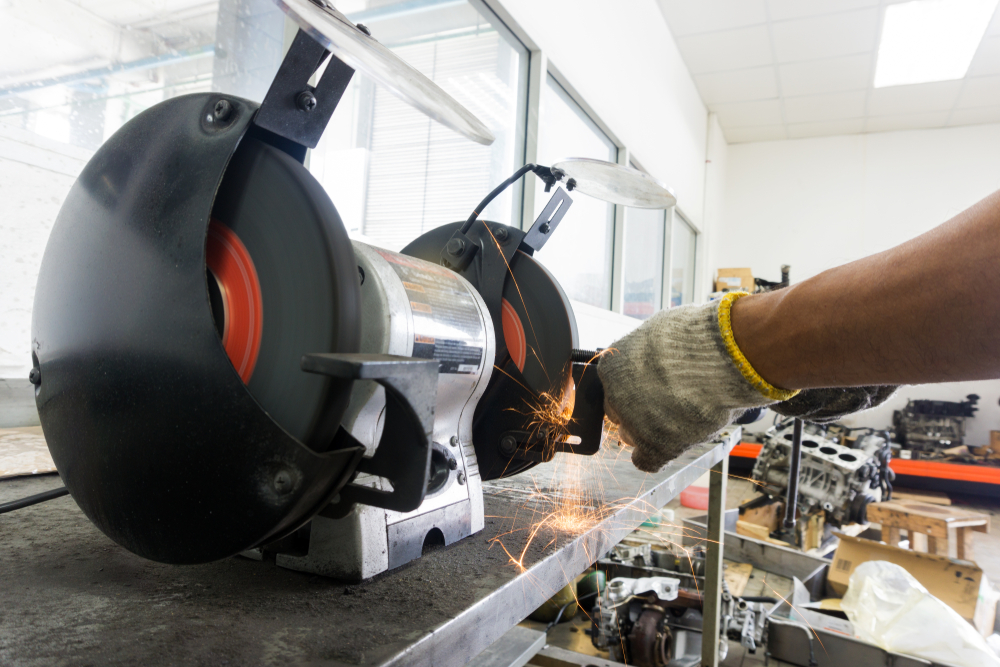
When it comes to grinding, sharpening, or shaping materials, a bench grinder is an indispensable tool. Whether you’re a professional tradesperson or a DIY enthusiast, having the right type of bench grinder can make all the difference in achieving precise and efficient results.
In this article, I’ll explore the different types of bench grinders available in the market and their specific uses. We’ll discuss the features and components of a bench grinder, including the different types of grinding wheels used. I’ll also provide important safety tips for using a bench grinder effectively and efficiently.
So, if you’re curious about what a bench grinder is, and how it works, or you’re simply looking to expand your knowledge on this versatile tool, keep reading!
Key Takeaways:
- There are various types of bench grinders available, each with its own unique features and uses.
- Understanding the key components of a bench grinder, such as grinding wheels and motor power, is essential for choosing the right one.
- Bench grinders can be used for grinding, sharpening, shaping, and more, making them versatile tools in many industries.
- Ensuring safety when using a bench grinder is crucial, and following proper precautions can help prevent accidents and injuries.
- Choosing the right bench grinder for your needs requires considering factors such as grinding tasks, budget, and quality.
Benefits of Using a Bench Grinder:
- Versatility: Bench grinders can be used for a wide range of applications, such as sharpening tools, shaping metal, removing rust, and polishing surfaces. They offer versatility and efficiency in various projects.
- Precision sharpening: With the help of grinding wheels, bench grinders allow you to achieve precise and consistent sharpening of different tools, such as chisels, knives, drill bits, and more.
- Time-saving: By using a bench grinder, you can save time and effort in manual grinding tasks. The high-speed rotation of the wheels speeds up the grinding process, ensuring quicker results.
- Cost-effective: Investing in a bench grinder can save you money in the long run. Instead of replacing dull or worn-out tools, you can restore their sharpness and extend their lifespan with regular grinding and sharpening.
- Efficiency: Bench grinders offer efficient material removal, making them ideal for shaping or smoothing rough surfaces, removing burrs, or preparing materials for further processing.
What Is a Bench Grinder?
A bench grinder is a versatile power tool used for various grinding, sharpening, and shaping tasks. It consists of a motor that drives rotating grinding wheels, typically made of abrasive materials like aluminium oxide, silicon carbide, or ceramic.
The primary function of a bench grinder is to remove material from a workpiece through grinding or sharpening. It is commonly used for sharpening blades, tools, and drill bits, as well as shaping metal and other materials. With the right grinding wheel and technique, a bench grinder can be used for tasks ranging from smoothing rough edges to creating intricate bevels.
Bench grinders are essential in many industries, including metalworking, woodworking, and automotive. They are especially useful in professional workshops and DIY projects requiring precision and efficiency. The robust design and powerful motor of a bench grinder make it capable of handling various materials and tasks with ease.
Overall, the purpose of a bench grinder is to enhance productivity and efficiency in grinding, sharpening, and shaping applications. Its versatility and effectiveness make it an indispensable tool for professionals and hobbyists alike.
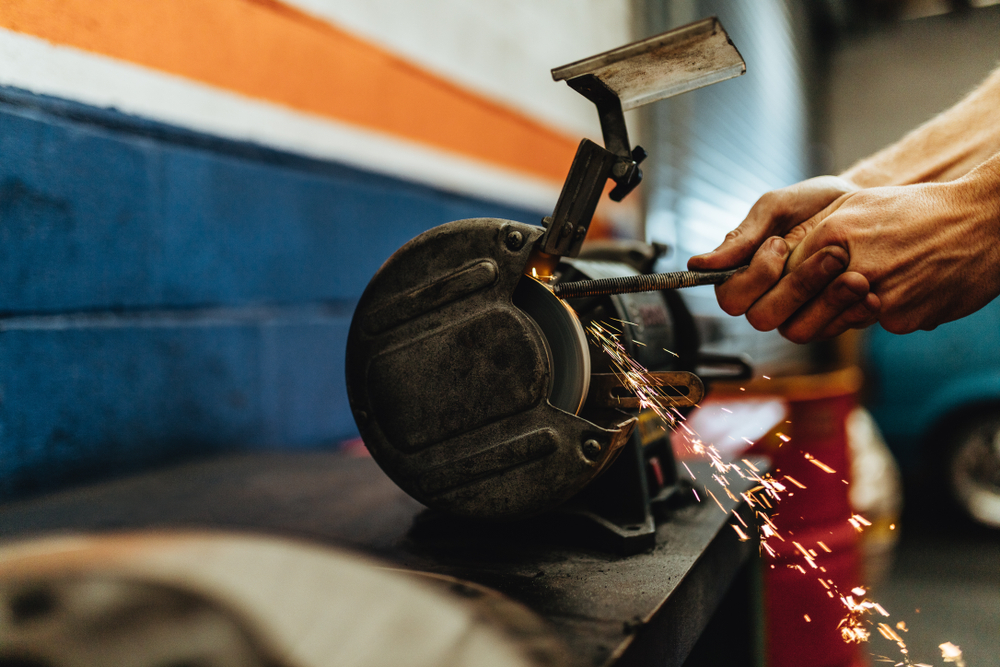
Different Types of Bench Grinders
In this section, I will discuss the various types of bench grinders available in the market. These bench grinder variants can be classified based on wheel size, power source, and specific uses in different industries. Understanding the differences and features of each type can help you choose the right bench grinder for your needs.
Let’s first explore the different classifications based on wheel size. Bench grinders come in various wheel sizes, ranging from small compact models to larger industrial-grade machines. The table below provides an overview of the different wheel size variants:
| Wheel Size | Common Uses |
|---|---|
| 6-inch | Entry-level models for light-duty tasks |
| 8-inch | Versatile size for general-purpose grinding |
| 10-inch | Large size suitable for heavy-duty applications |
In addition to wheel size, bench grinders can also be classified based on their power source. The most common types include electric bench grinders and battery-operated bench grinders. Electric bench grinders are widely used due to their consistent power supply, while battery-operated models offer portability and flexibility.
Furthermore, bench grinders can be specialized for specific industries and applications. Let’s take a look at some of the common speciality grinders:
- Automotive Bench Grinders: Designed for tasks such as sharpening blades, removing rust, and polishing metal in automotive repair and maintenance.
- Woodworking Bench Grinders: Equipped with specific grinding wheels suitable for shaping, sharpening, and buffing wood materials.
- Metalworking Bench Grinders: Designed for heavy-duty metal grinding and deburring tasks in metal fabrication and manufacturing.
It’s important to consider the specific needs of your industry or application when choosing a bench grinder.
By understanding the different types and variants of bench grinders, you can make an informed decision based on your specific requirements. Whether you need a compact bench grinder for light-duty tasks or a larger industrial-grade machine, there is a bench grinder out there to meet your needs.
Exploring the Varieties of Bench Grinders
In this section, we will dive deeper into the different varieties of bench grinders and explore their unique features and applications. From wheel size variants to speciality grinders for specific industries, we will cover all aspects of bench grinder variety. Additionally, we will discuss the differences in power and motor options, as well as the benefits of variable-speed bench grinders.
Wheel Size Variants
One of the key factors to consider when choosing a bench grinder is the size of the grinding wheel. Bench grinders are available with various wheel sizes, each offering different advantages for specific tasks. Larger wheel sizes, such as 8 or 10 inches, are ideal for heavy-duty grinding and sharpening applications. On the other hand, smaller wheel sizes, like 6 inches, are more suitable for finer precision work and detail-oriented tasks.
When selecting the right wheel size for your bench grinder, consider the type of work you will be performing. If you primarily work with large, sturdy materials, a grinder with a larger wheel size would be more effective. Conversely, if you deal with delicate or intricate items, a bench grinder with a smaller wheel size would provide better control and precision.
Specialty Grinders for Different Industries
Bench grinders are designed to cater to the specific needs of different industries. Whether you work in automotive, woodworking, or metalworking, there is a speciality bench grinder available to enhance your productivity and efficiency.
For automotive applications, bench grinders equipped with wire brushes and buffing wheels are commonly used for cleaning and polishing metal surfaces.
Woodworking bench grinders often feature wider wheels that are optimal for shaping and smoothing wooden pieces.
Metalworking bench grinders, on the other hand, are designed with strong motors and abrasive wheels to tackle heavy-duty grinding and deburring tasks.
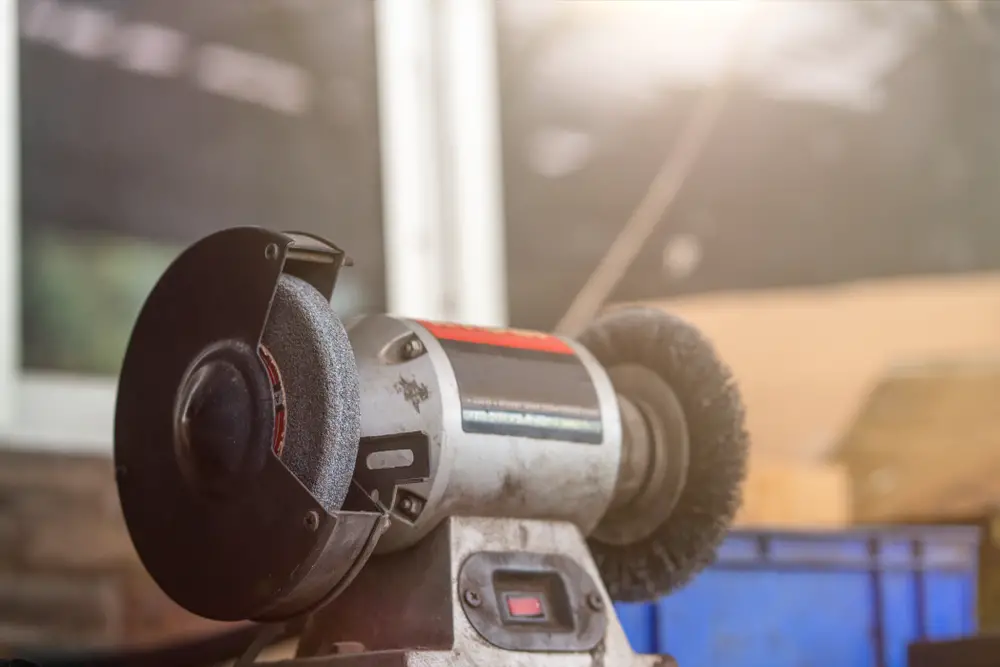
Power and Motor Differences
Bench grinders come with different power sources and motor options to suit various needs and preferences. The most common power source for bench grinders is electricity, with electric bench grinders offering consistent and reliable performance. However, there are also battery-operated bench grinders available, providing a cordless and portable solution for those who require mobility.
Motor power is another important consideration when choosing a bench grinder. Higher horsepower ratings indicate a more powerful motor, capable of handling tougher materials and demanding tasks. If you frequently work with hard metals or require heavy grinding, a bench grinder with a higher horsepower motor would be a suitable choice. However, for lighter applications, a bench grinder with a lower horsepower motor may be sufficient.
Besides power, some bench grinders also offer variable speed options. A variable-speed bench grinder allows you to adjust the rotation speed of the grinding wheel, providing better control and versatility. This feature is particularly beneficial when working with different materials or when precision is paramount.
Key Components and Their Functions
In this section, I will discuss the key components of a bench grinder and their functions. Understanding these components is important for using a bench grinder effectively and safely.
Understanding Grinding Wheel Materials
The grinding wheel is a crucial component of a bench grinder, responsible for removing material and shaping the workpiece. Different types of materials are used to create grinding wheels, each with its own specific properties. Common grinding wheel materials include:
- Aluminium Oxide Wheels: Versatile and suitable for general-purpose grinding tasks.
- Silicon Carbide Wheels: Ideal for grinding hard and brittle materials like carbide tools.
- Ceramic Wheels: Known for their exceptional durability and heat resistance.
| Grinding Wheel Materials | Properties |
|---|---|
| Aluminum Oxide Wheels | Versatile, suitable for general-purpose grinding |
| Silicon Carbide Wheels | For grinding hard and brittle materials |
| Ceramic Wheels | Durable and heat-resistant |
By understanding the characteristics of these grinding wheel materials, you can choose the right type for your specific grinding needs.
Let’s Talk About Safety Features
Safety is paramount when using a bench grinder. Manufacturers incorporate various safety features into their designs to ensure user protection. Some common safety features found in bench grinders include:
- Safety Shields: These transparent protective covers enclose the grinding wheel to prevent debris and sparks from injuring the operator.
- Adjustable Tool Rests: These provide support for the workpiece and help maintain a consistent grinding angle, reducing the risk of accidents.
It is important to follow safety precautions when using a bench grinder, such as wearing appropriate personal protective equipment, maintaining a safe distance from the grinder, and avoiding excessive force or pressure on the workpiece.
How to Choose the Right Bench Grinder
In order to choose the right bench grinder for your specific needs, there are several factors to consider. Assessing your grinding needs is the first step. Determine the purpose of the bench grinder and evaluate the frequency of its use. Identify the specific grinding tasks you will be performing to ensure that the bench grinder you choose is capable of handling them effectively.
Budget and quality considerations are also important when choosing a bench grinder. It’s important to set a budget for your purchase and strike a balance between cost and quality. Remember that a higher-quality bench grinder may be more expensive, but it will likely be more durable and offer better performance in the long run. Consider choosing a reliable bench grinder brand to ensure you invest in a reputable and trustworthy product.
By carefully assessing your grinding needs and considering both budget and quality, you can select the right bench grinder that meets your specific requirements. Whether you are a DIY enthusiast or a professional, choosing the right bench grinder will ensure that you have a reliable tool for all your grinding tasks.
Proper Use and Maintenance Tips for Bench Grinders
Using a bench grinder requires adherence to proper safety precautions and regular maintenance to ensure optimal performance and longevity. Here are some essential tips to follow when operating and maintaining your bench grinder:
- Wear appropriate protective gear: Always wear safety glasses or a face shield to protect your eyes from sparks and debris. Additionally, use ear protection and gloves to safeguard against noise and potential injuries.
- Maintain a safe distance: Keep a safe distance from the bench grinder while it’s in operation to minimise the risk of accidents. Do not lean over the grinder or directly in line with the grinding wheel.
- Inspect and maintain grinding wheels: Regularly inspect your grinding wheels for any damage, cracks, or excessive wear. Replace any damaged or worn-out wheels immediately to prevent accidents. Additionally, make sure the wheels are properly balanced for smooth and efficient operation.
- Wheel dressing: Dressing the grinding wheels involves removing any glazing or debris that may accumulate on the surface. This can be done using a wheel dressing tool or a diamond dresser. Proper wheel dressing helps to maintain the sharpness and effectiveness of the grinding wheels.
- Wheel cleaning: Clean the grinding wheels regularly to remove any metal particles or debris that may become lodged in the wheel’s surface. Use a wheel brush or a wheel cleaning stick to remove the buildup, ensuring optimal performance and preventing overheating of the wheels.
By following these tips, you can ensure the safe and efficient use of your bench grinder while maximising its lifespan. Remember to always prioritize safety and perform regular maintenance to keep your bench grinder in top working condition.
Conclusion
In conclusion, we have explored the different types of bench grinders and their specific uses. We have discussed the features and components of a bench grinder, including the various types of grinding wheels used. It is important to choose the right type of bench grinder for your needs, considering factors such as wheel size, power source, and industry-specific requirements.
When using a bench grinder, safety should always be a top priority. It is crucial to follow the recommended safety precautions, such as wearing protective gear and maintaining a safe distance. Regular inspection and maintenance of the grinding wheels are also essential for optimal performance.
Remember, the right bench grinder can make a significant difference in your workshop or industrial applications. So, take the time to assess your grinding needs, consider your budget and quality requirements, and choose a reliable bench grinder brand. With the right bench grinder and a focus on safety, you can achieve excellent results while ensuring your well-being.
FAQ
What are the different types of bench grinders available in the market?
The different types of bench grinders include those with varying wheel sizes, power sources, and specific uses in different industries.
What is a bench grinder and how does it work?
A bench grinder is a versatile tool used for grinding, sharpening, and shaping different materials. It works by rotating grinding wheels or belts at high speeds to remove material and provide a smooth finish.
What are the key components of a bench grinder and their functions?
The key components of a bench grinder include grinding wheels made of different materials, a motor that powers the rotation of the wheels, and safety features such as adjustable tool rests and safety shields.
What are the different varieties of bench grinders based on wheel size?
Bench grinders come in various wheel sizes, such as 6-inch, 8-inch, and 10-inch. The choice of wheel size depends on the specific applications and tasks you need to perform.
Are there speciality grinders available for different industries?
Yes, there are speciality bench grinders designed for specific industries, such as automotive, woodworking, and metalworking. These grinders have unique features and functionalities tailored to the needs of each industry.
What are the power and motor differences in bench grinders?
Bench grinders can differ in terms of power sources, such as electric or battery-operated, and motor power, which is usually measured in horsepower. There are also variable speed options available for enhanced control and precision.
What are the different grinding wheel materials used in bench grinders?
Bench grinders use various grinding wheel materials, including aluminium oxide, silicon carbide, and ceramic. Each material has its characteristics and is suitable for different grinding tasks and materials.
How do I choose the right bench grinder for my needs?
To choose the right bench grinder, you should assess your grinding needs, consider your budget and quality requirements, and choose a reliable brand that offers the features and specifications that align with your specific requirements.
What are the safety precautions when using a bench grinder?
It is important to wear appropriate protective gear, maintain a safe distance from the grinder, inspect and maintain the grinding wheels regularly, and follow proper wheel dressing and cleaning techniques to ensure optimal safety and performance.
- Drill Battery Maintenance: Essential Tips for Cordless Drill Battery Care - February 5, 2024
- Troubleshooting Drill Issues - February 5, 2024
- Quick Drilling Techniques - February 2, 2024


